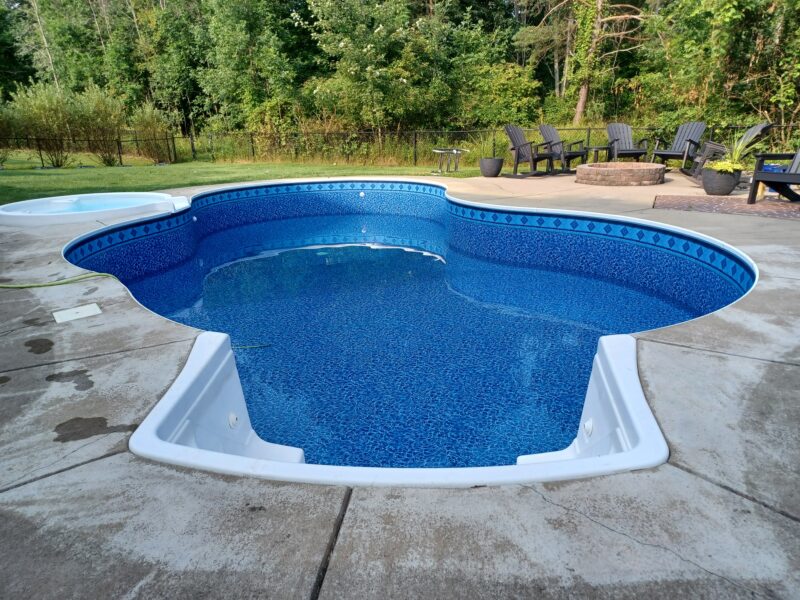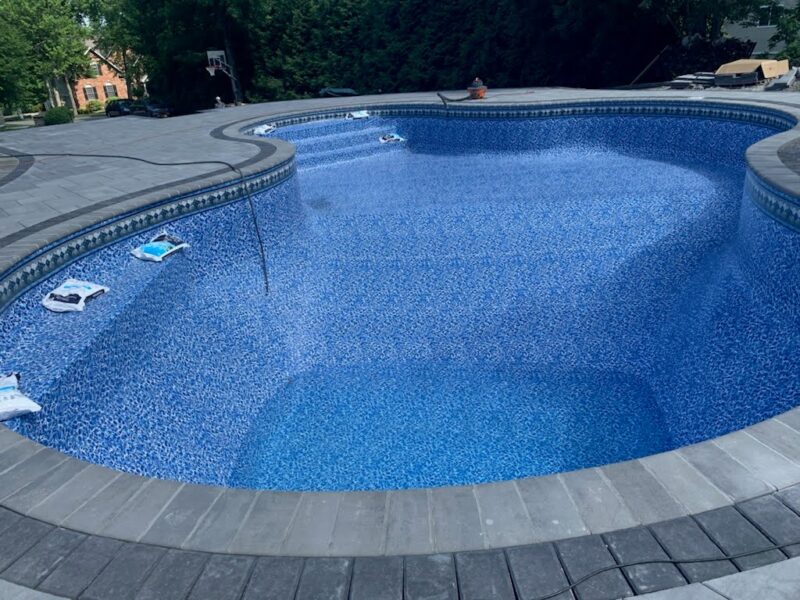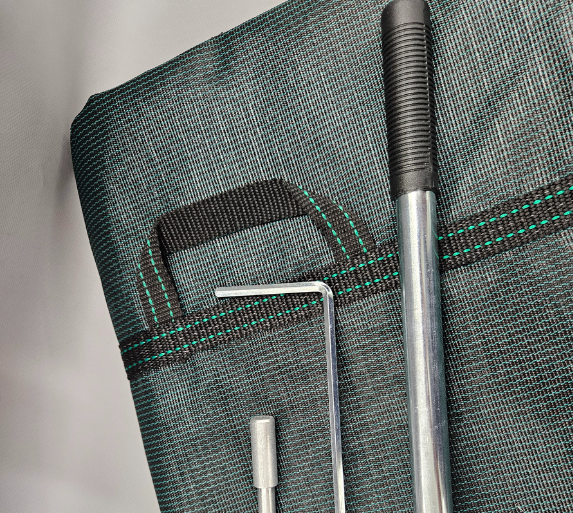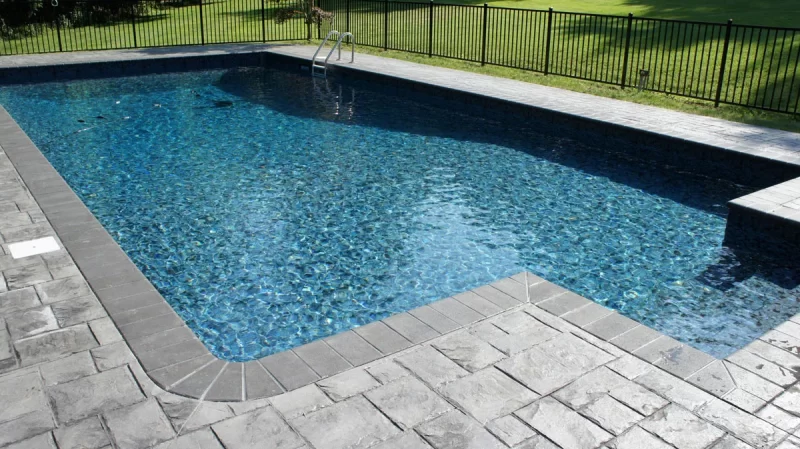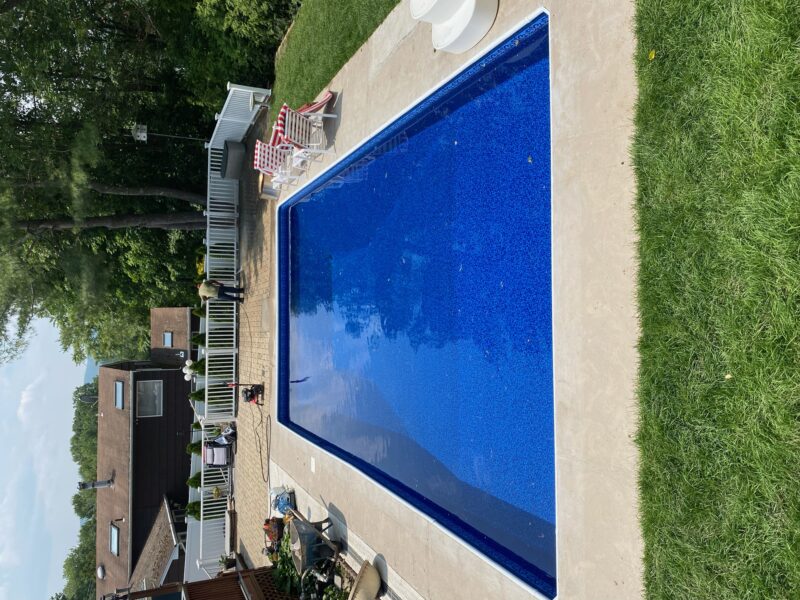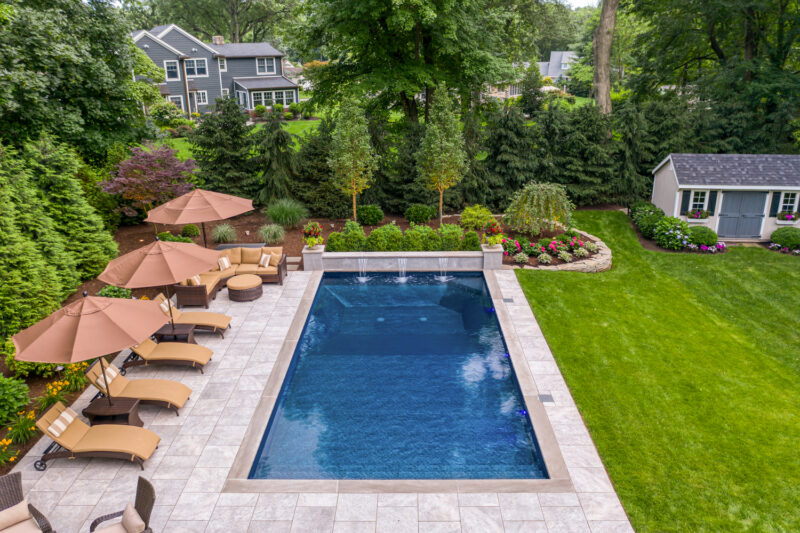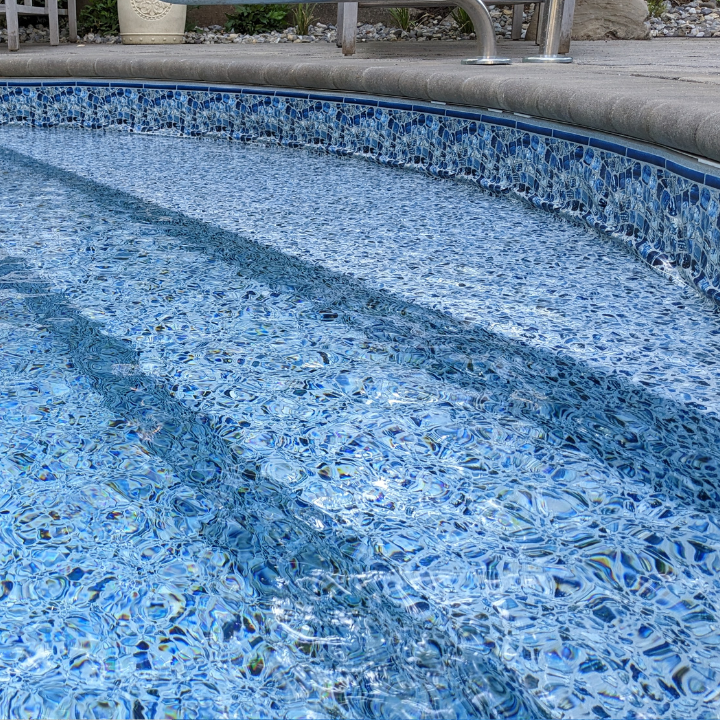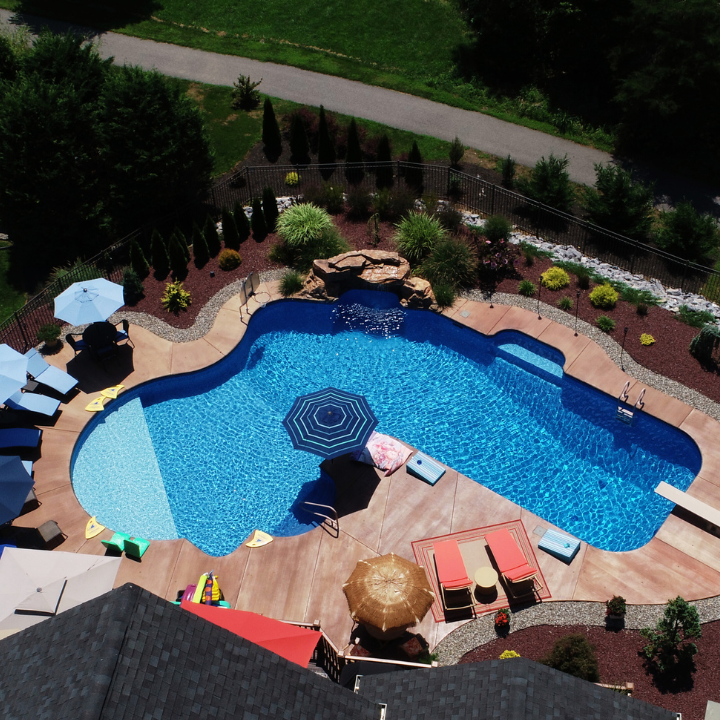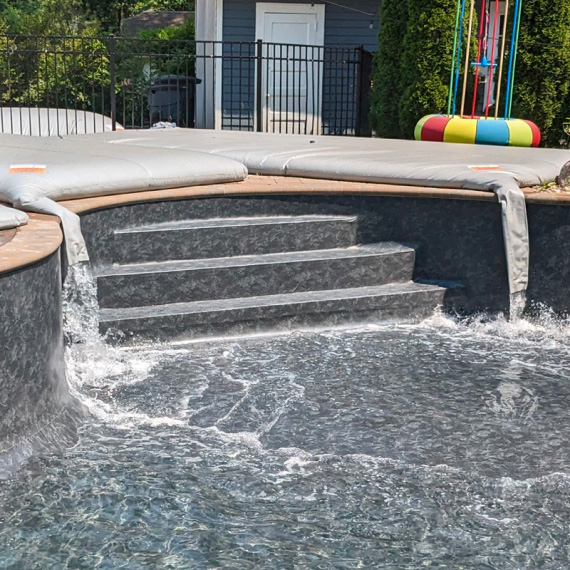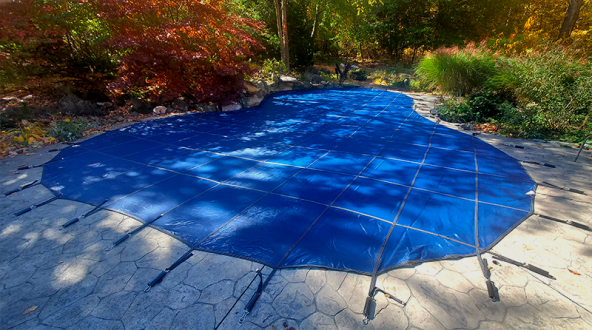How to Drain a Pool & Reuse Pool Water After Liner Replacements
Pool drains must be conducted every few years to keep a pool out of disrepair and ensure proper water quality. Likewise, as time passes, pool components like pool liners may show signs of wear and tear, which may require you to install a new one.
Forgo a pool liner replacement and pool drainage, and you could be forking out a hefty chunk of change for pool maintenance.
To help you avoid potential damage and costly errors — and to save you time and hassle — we wanted to share our experience on how to drain a pool after a pool liner replacement.
Believe us: after 20+ years in the industry, you’ll want to know how to drain a pool after a liner replacement.
To help you with the strenuous task of draining a pool to access and therefore replace a pool liner, we’ll discuss:
- Why draining a pool is important
- When to conduct a pool drain
- Tools and materials to use with pool drains
- How to best prepare for pool drainages
- The process of draining above- and in-ground pools
- What to expect during the pool drainage process
- What to do after the pool drainage process
- The phenomena of “pool pop”
The importance of draining a pool
A pool liner replacement is an excellent option when the time comes for pool renovations. Plus, pool liner replacements offer significant benefits. Replacing a pool liner is one of the many situations where pool draining is necessary.
A few other situations where a pool drain might be needed include:
- When the time comes for a major pool repair or renovation
- When installing a pool cover and preparing for the winter
- When conducting routine maintenance
- When addressing problems with a pool’s structure
But how does one know when the best time is to conduct a pool drain?
When to conduct a pool drain
With a pool drain, timing is everything. The best time to drain a pool is during mild weather conditions.
For example, the best time to conduct a pool drain is in dry weather with daytime temperatures of about 85 degrees.
We recommend the spring or the fall seasons, and we suggest avoiding extreme temperatures. Sweltering heat can damage an empty pool’s surfaces, and winter’s frozen ground can cause a phenomenon called “pool pop” (more on this later).
What’s more, rainy seasons increase the risk of hydrostatic pressure issues (we’ll also discuss this later).
Tools and materials to use with pool drains
Once the weather is right, you’ll want the right tools, pool equipment, and materials to drain your pool. Tools and materials for a pool drain include:
- Garden hoses that can reach from the pool to the drainage point
- A hammer
- Large pliers
- For in-ground pools, replacement hydrostatic plugs
- Screwdrivers
- Submersible pumps
- A submersible-pump-to-garden-hose adapter
Safety tips for better pool drains
Once you’ve assembled your tools, make sure you and your team gather the right safety equipment for your needs. Having replaced a few liners ourselves, here are a few tips on ensuring a smoother liner replacement and pool drain:
- Wear non-slip shoes, gloves, and eye protection.
- Have a helper nearby in case of emergencies.
- Follow electrical safety guidelines when using pumps.
- Avoid using extension cords near the water.
By approaching your pool drain with a safety-first mindset, you’ll keep pool liner costs at a minimum.
Did you know?
Did you know there’s a better solution to water refills after a pool liner installation? Worried about wasting money on water to refill your pool after liner installation?
Order a Pool Bladder™ today to store your water during the pool liner installation process!
How to prepare for pool drainage
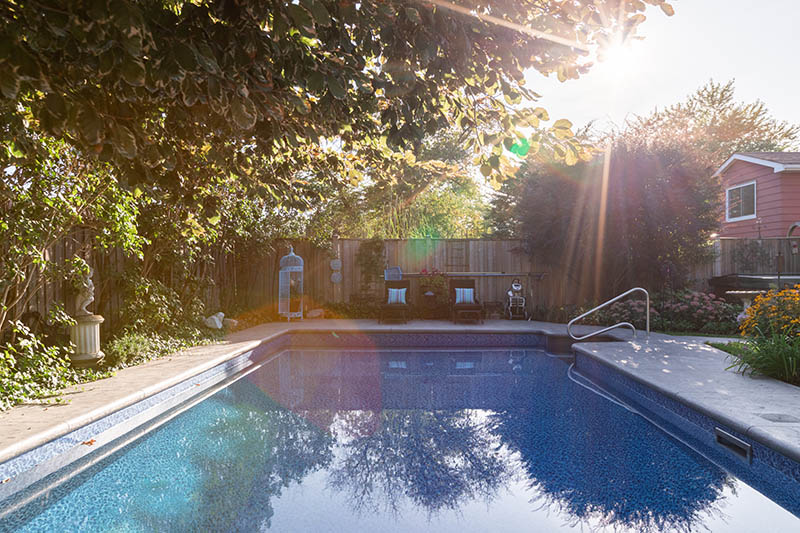
To prepare for pool drainage, you’ll want to keep in mind the following two aspects:
- Consult local authorities
- Check up on weather conditions
Get in touch with your local water authorities
Before draining a pool, you’ll want to check in with your local water authority. Many municipalities have specific regulations about pool drainages, including (but not limited to):
- Where and when you can drain pool water
- The chemical composition requirements for discharged water
If you don’t comply with regulations, you may incur fines or other penalties, so we always recommend following the rules of your local jurisdiction. The environment and your wallet will be happier for it.
Keep tabs on weather conditions
Before and during the draining process, you’ll want to keep tabs on the weather. Dry weather a few days before and after the draining process is ideal.
Anywhere from 50-80 degrees Fahrenheit with low humidity is also ideal. If you see that rain is expected, avoid draining your pool.
Rain can cause hydrostatic pressure issues and damage to the pool’s structure.
Draining an above-ground pool
When the time comes to perform a pool drain, above-ground pools tend to be more simple than in-ground pools. The process of draining an above-ground pool is as simple as:
- Preparing the pool drainage system
- Monitoring the draining process
Prepare the pool drainage system
To set up the pool’s drainage system follow these five fast steps:
- Unplug all electrical components, including the pool pump and automatic timers.
- Attach garden hoses that can reach from the inside of the pool to the drainage point.
- Connect the garden hoses to the submersible pump.
- Lower the pump into the deepest part of the pool.
- Plug the pump into a ground fault circuit interrupter (GFCI) outlet near the pool.
After setting up the pool drainage system, you’re ready to monitor and check the draining process.
Check the draining process
When checking the draining process, start the pump and check that the water is flowing at the drainage point. Monitor the process to ensure that the pump doesn’t run dry.
As the water level drops, move the pump to the lowest point in the pool. Once the water level is at a low enough level that the pump can no longer suck water up, use a shop vacuum (or sponges) to remove any remaining water.
Note: draining a pool takes a while — like up to 14 hours “a while.” You’ll want to have someone else who can watch over the draining process with you to ensure a seamless process.
Draining an in-ground pool
In-ground pools are a different story. They need extra care, as structural damage can occur if the draining process isn’t monitored.
The process of draining an in-ground pool involves:
- Removing water from and avoiding damage to the pool’s structure
- Dealing with hydrostatic pressure
Start by removing water
The process of removing water (and avoiding structural damage) to an in-ground pool involves the following five steps:
- Turn off all pool equipment, including pumps, lights, and automatic systems.
- Set up your submersible pump and hoses (as described in the section above about above-ground pools).
- Pump water from the deepest part of the pool.
- Monitor the process, moving the pump as needed.
- When the water level reaches a level that’s too low for the pump, be ready to reduce hydrostatic pressure.
Address hydrostatic pressure
Hydrostatic pressure: it’s the pressure that water (or other fluids) have on an object. With pool drains, pre-pool liner replacement, dealing with hydrostatic pressure is a huge concern.
If, during the pool drain process, enough hydrostatic pressure builds up, a pool shell can crack, bulge, or float.
To reduce the risk of hydrostatic pressure, follow the following four steps:
- Locate the hydrostatic plugs in the pool floor. The plugs can usually be found in the deep end of the pool.
- Break the plaster covering the plugs, remove the plugs with pliers, and allow the groundwater to enter the pool.
- Pump out water as it enters.
- When you’re ready to refill the pool, replace the hydrostatic plugs.
Above-ground vs. in-ground pool drains
| Draining an above-ground pool | Draining an in-ground pool |
|
|
Watch out for “pool pop”
Pool pop refers to the underground pressure that forces an empty in-ground pool upward. This phenomenon occurs when the thousands of gallons of pool water that once weighed down a pool floor are quickly released.
The process of the release — and the ensuing pressure from around the pool — can quite literally push the pool floor up and above the ground.
The result? One clean side of a pool, a pile of broken shards and materials at the other end of the pool.
To prevent pool pop, make sure to adhere to these pool drain best practices:
- Drain pools only during dry weather when water tables are low.
- Remove hydrostatic plugs when draining the pool (for in-ground pools).
- Never leave an in-ground pool empty of water for long periods.
- Refill the pool as soon as you can after completing a pool liner replacement, maintenance, or repair.
During the pool drainage process: Protect the pool’s surfaces
As mentioned above with “pool pop,” damage can occur if a pool remains empty for long periods — especially in hot weather. To project a pool’s surface during the drainage process, we recommend the following:
- Avoid draining during extreme temperatures.
- If your pool must stay empty for more than one day, keep its surface damp.
- Cover the pool with a safety cover to protect it from debris and sunlight.
- If repairs or maintenance are needed, be as efficient as possible to minimize the harmful effects of prolonged sun exposure.
After pool drainage: maintaining and refilling the pool
Upon finishing the pool drainage after a pool liner replacement, you’ll want to conduct cleaning, repairs, and proper refilling. Proper technique and equipment are essential to maintain the health and longevity of a pool.
Conduct cleaning and repairs
An empty pool isn’t such a bad thing. In fact, you can take advantage of an empty pool to conduct maintenance and pool cleaning.
After draining a pool, take a look at the pool to replace worn equipment, fix any cracks or damage, and clean surfaces. A little maintenance can save a ton of time and money in the long run.
Work with proper refilling techniques and equipment
When the time comes to refill the pool, you’ll want to replace all hydrostatic plugs (for in-ground pools, that is). Use a garden hose to begin filling the pool.
Make sure to add water at a slow, even pace. Doing so will help you avoid disrupting any repairs, cleaning, and maintenance you’ve just conducted.
Then, balance the chemicals once the pool is about 75% full. You can then run the filtration system once the pool is full. Doing so will ensure the proper circulation of chemicals and water in the pool.
Finally, once you’re done, have a unique and handy water storage tool nearby for your next pool refill. We’ll discuss what we use for our pool storage tools in the next and final section of this guide.
Try Kayden’s Pool Bladder for post-drainage pool refills
One of the most strenuous tasks involved in pool maintenance, liner replacements, and general pool repairs is draining and storing pool water.
Wasting water is a nightmare. For many pool owners, conserving as much water as possible is the goal.
For this reason, Kayden Pool Liners has created a unique and handy tool — the Pool Bladder — that can prevent the need for inefficient, wasteful, and costly pool drainage.
The Pool Bladder is not only an excellent alternative to draining pools for a pool liner replacement but also comes in handy for any needed pool maintenance. This handy water storage unit can help prevent water wastage while being a quicker and easier alternative to filling a pool back up after drainage.
We’re all about making your next pool drain seamless and uneventful. We’re all about making your next pool drain seamless and uneventful. With the fiberglass pool market expected to grow over the next decade (Market Research Intellect, 2024), there’s never been a better time to take stock of better pool resources.
To find out more about how to make a pool liner replacement and pool drain easier with our Pool Bladder, contact us today at (201) 880-9898.
P.S. – So, you actually read through this whole blog. And, we must apologize profusely for how nonsensical it may have seemed at times. But, you’re actually amazing.
You should really click on the link below and talk to us, because we’ll share just what you’re looking for in our time together. Thanks for reading. We just like to keep you on your toes.
More Helpful Content for You
10 Simple Pool Liner Cleaning/Care Tips to Keep Pool Liners Clean
A pool liner can last anywhere from five to 20…
6 Benefits of Being a Kayden Dealer
In the world of pool building and renovation, the products…
A Quick and Comprehensive Guide to How to Clean a Pool Cover
Keeping a pool maintained and serviced is a no-brainer. But,…

